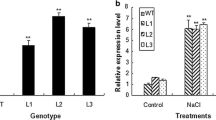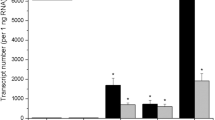Summary
Mutagenesis and the subsequent selection of mesophyll diploid protoplasts ofNicotiana sylvestris on growth inhibitory concentrations of lysine plus threonine has led to the isolation of an LT-resistant mutant. Regeneration of this line (RLT 70) and analysis of its descendants demonstrated the dominant monogenic nuclear character of the resistance gene, further namedak-LT1. When the inhibition properties of aspartate kinase were examined in the homozygous mutant, lysine-sensitive activity could no longer be detected. In comparison, 70%–80% of the wild-type enzyme activity was usually inhibited by lysine, and the rest by threonine. Evidence for the existence of at least two AK isoenzymes was obtained by ion-exchange chromatography, where two peaks of activity could be detected: the first one to be eluted is lysine sensitive, and the second one threonine sensitive. One consequence of the altered regulation of AK in the mutant was the enhanced production of soluble threonine. Threonine accumulation was observed to occur throughout the life cycle of the mutant plant as well as in its different organs. In particular, leaves exhibited a 45-fold increment of soluble threonine, which corresponds to a 13-fold increase in total threonine: almost one-third of the total amino acids was free and proteinbound threonine. In RLT 70 seeds, 20% of the free amino acid pool was in the form of threonine (70-fold accumulation compared to the wild type), and total threonine content was increased five fold. As a general rule, the other amino acids were also more abundant in RLT 70 seeds, such that the total of amino acids present was between two to four times higher, but in contrast with the situation encountered in leaves, this was also due to a higher protein-bound amino acid content.
Similar content being viewed by others
Abbreviations
- AK :
-
aspartate kinase
- DHDPS :
-
dihydrodipicolinate synthase
- AEC :
-
S-(2-aminoethyl)L-cysteine
- LT :
-
lysine plus threonine
- AdoMet :
-
S-adenosyl-methionine
References
Aarnes H, Rognes SE (1974) Threonine-sensitive aspartate kinase and homoserine deshydrogenase fromPisum sativum. Phytochemistry 13:2717–2724
Arruda P, Bright SWJ, Kueh JSH, Lea PJ, Rognes SE (1984) Regulation of aspartate kinase isoenzymes in barley mutants resistant to lysine plus threonine. Plant Physiol 76:442–446
Bielisky RL, Turner NA (1966) Separation and estimation of amino acids in crude extracts by thin-layer electrophoresis and chromatography. Anal Biochem 17:278–293
Bourgin JP, Chupeau Y, Missonier C (1979) Plant regeneration from mesophyll protoplasts of severalNicotiana species. Physiol Plant 45:288–292
Bourgin JP, Chupeau MC, Missonier C (1982) Amino acid resistant plants from tobacco cells selected in vitro. In: Earle ED, Demarly Y (eds) Variability in plants regenerated from tissue culture. Praeger, New York, pp 163–174
Bradford MM (1976) A rapid and sensitive method for the quantitation of microgram quantities of protein utilizing the principle of protein-dye binding. Anal Biochem 72:248–254
Bright SWJ, Fetherstone LC, Miflin BJ (1979) Lysine metabolism in a barley mutant resistant to S-aminoethylcysteine. Planta 146:629–633
Bright SWJ, Kueh JSH, Franklin J, Rognes SE, Miflin BJ (1982) Two genes for threonine accumulation in barley seeds. Nature 299:278–279
Bryan JK (1980) Synthesis of the aspartate family and branched-chain amino acids. In: Miflin BJ (ed) The biochemistry of plants, vol. 5: amino acids and derivatives. Academic Press, New York, pp 404–452
Bryan PA, Cawley RD, Brunner CE, Bryan JK (1970) Isolation and characterisation of a lysine-sensitive aspartokinase from a multicellular plant. Biochem Biophys Res Commun 41:1211–1217
Cattoir-Reynaerts A, Degryse E, Verbruggen I, Jacobs M (1983) Selection and characterisation of carrot embryoid cultures resistant to inhibition by lysine plus threonine. Biochem. Physiol Pflanzen 178:81–90
Diedrick TJ, Frisch DA, Gengenbach BG (1990) Tissue culture isolation of a second mutant locus for increased threonine accumulation in maize. Theor Appl Genet 79:209–215
Dotson SB, Somers DA, Gengenbach BG (1989) Purification and characterization of lysine-sensitive aspartate kinase from maize cell cultures. Plant Physiol 91:1602–1608
Dotson TJ, Frisch DA, Somers DA, Gengenbach BG (1990) Lysine-insensitive aspartate kinase in two threonine-overproducing mutants of maize. Planta 182:546–552
Ghislain M, Frankard V, Jacobs M (1990) Purification and characterization of dihydrodipicolinate synthase ofNicotiana sylvestris (Spegg. and Comes). Planta 180:480–486
Giovanelli J, Mudd SH, Datko A (1989) Aspartokinase ofLemna paucicostata Hegelm. 6746. Plant Physiol 90:1577–1583
Green CE, Phillips RL (1974) Potential selection system for mutants with increased lysine, threonine, and methionine in cereal crops. Crop Sci 14:827–830
Hibberd KA, Green CE (1982) Inheritance and expression of lysine plus threonine resistance selected in maize tissue culture. Proc Natl Acad Sci USA 79:559–563
Hibberd KA, Walter T, Green CE, Gengenbach BG (1980) Selection and characterization of a feedback-insensitive tissue culture of maize. Planta 148:183–187
Jacobs M, Negrutiu I, Dirks R, Cammaerts D (1987) Selection programs for isolation and analysis of mutants in plant cell cultures. In: Green CE, Somers DA, Hackett WP, Biesboer DD (eds) Plant biology, vol. 3: plant tissue and cell culture. Alan R. Liss, New York, pp 243–264
Kochar S, Kochar VK, Sane PV (1986) Isolation characterization and regulation of isoenzymes of aspartate kinase differentially sensitive to calmodulin from spinach leaves. Biochim Biophys Acta 880:220–225
Miao S, Duncan DR, Widholm JM (1988) Selection of regenerable maize callus cultures resistant to 5-methyl-Dl-tryptophane, S-2-aminoethyl-L-cysteine and high levels ofL-lysine plusL-threonine. Plant Cell Tissue Org Cult 14:3–14
Murashige T, Skoog F (1962) A revised medium for rapid growth and bioassays with tobacco tissue cultures. Physiol Plant 15:473–497
Negrutiu I, Cattoir-Reynaerts A, Verbruggen I, Jacobs M (1984) Lysine overproducer mutants with an altered dihydrodipicolinate synthase from protoplast culture ofNicotiana sylvestris (Spegazzini and Conies). Theor Appl Genet 68: 11–20
Piryns I, Vernaillen S, Jacobs M (1988) Inhibitory effects of aspartate-derived amino acids and aminoethyl cysteine, a lysine analog, on the growth ofSorghum seedlings; relation with three enzymes of the aspartate-pathway. Plant Sci 57:93–101
Relton JM, Bonner PLR, Wallsgrove RM, Lea PJ (1988) Physical and kinetical properties of lysine-sensitive aspartate kinase purified from carrot cell suspension. Biochim Biophys Acta 953:48–60
Rognes SE, Bright SWJ, Miflin BJ (1983) Feedback-insensitive aspartate kinase isoenzymes in barley mutants resistant to lysine plus threonine. Planta 157:32–38
Rognes SE, Lea PJ, Miflin BJ (1980) S-adenosylmethionine — a novel regulator of aspartate kinase. Nature 287:357–359
Vernaillen S, Van Ghelue M, Verbruggen I, Jacobs M (1985) Characterization of mutants inArabidopsis thaliana (L.) Heynh. resistant to analogs and inhibitory concentrations of amino acids derived from aspartate. Arabidopsis Inf Serv 22:13–22
Author information
Authors and Affiliations
Additional information
Communicated by P. Maliga
Rights and permissions
About this article
Cite this article
Frankard, V., Ghislain, M., Negrutiu, I. et al. High threonine producer mutant ofNicotiana sylvestris (Spegg. and Comes). Theoret. Appl. Genetics 82, 273–282 (1991). https://doi.org/10.1007/BF02190612
Received:
Accepted:
Issue Date:
DOI: https://doi.org/10.1007/BF02190612




